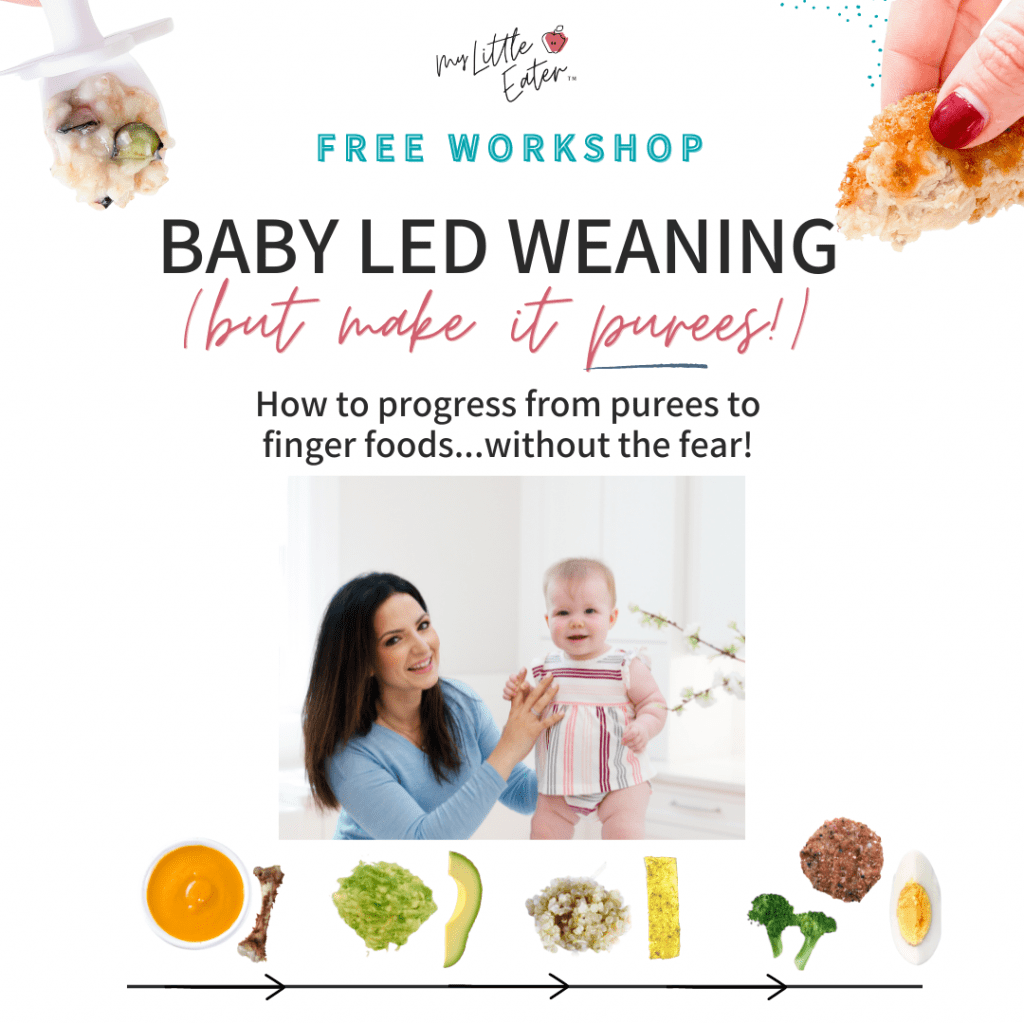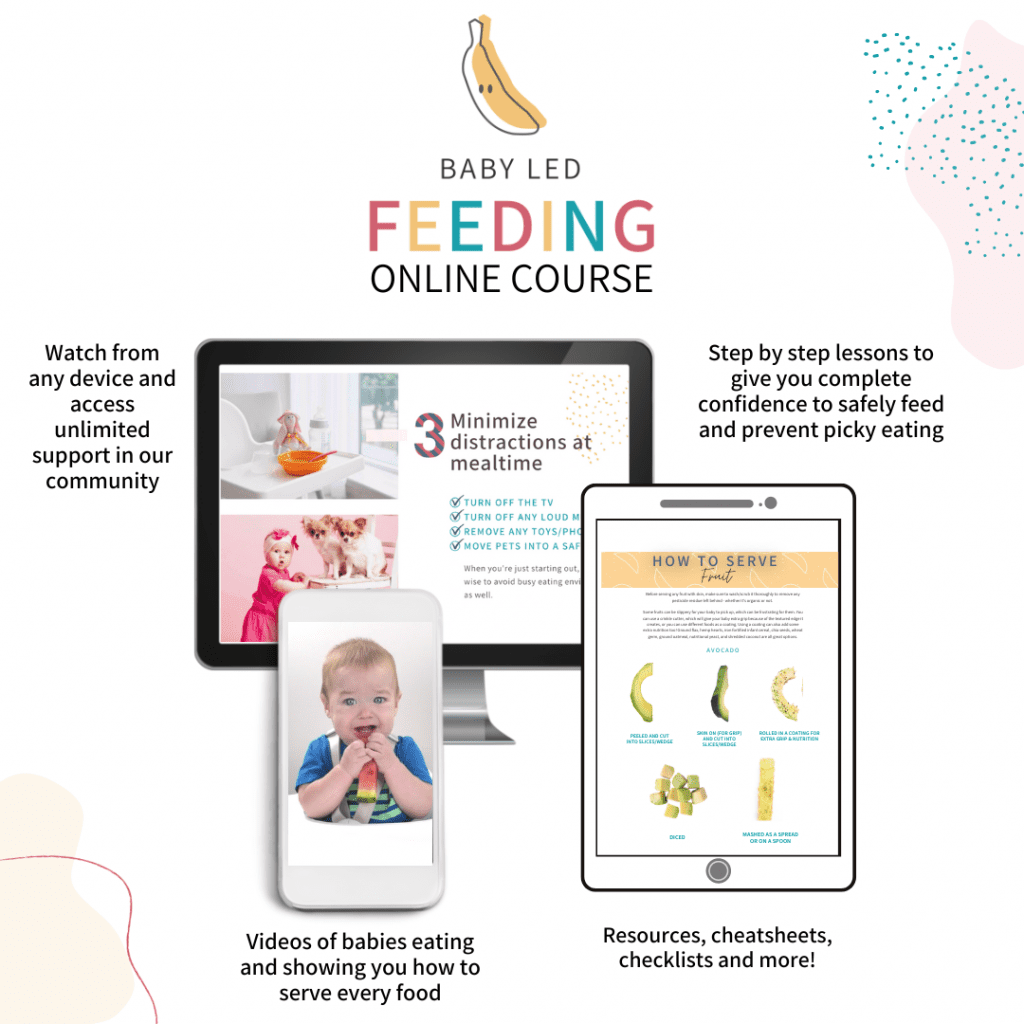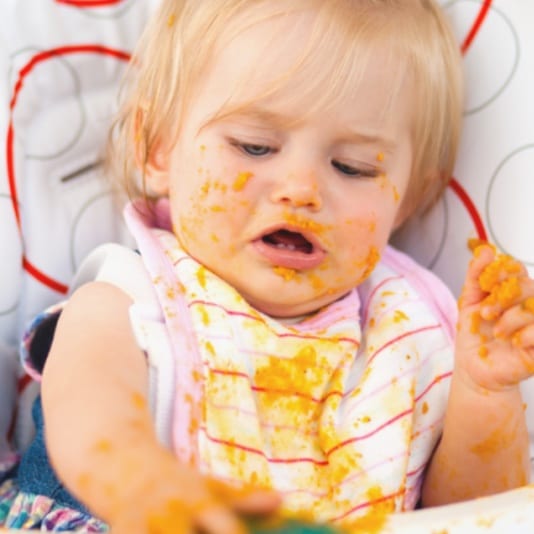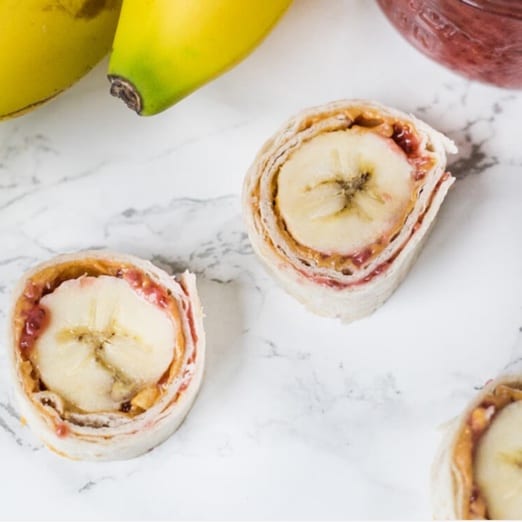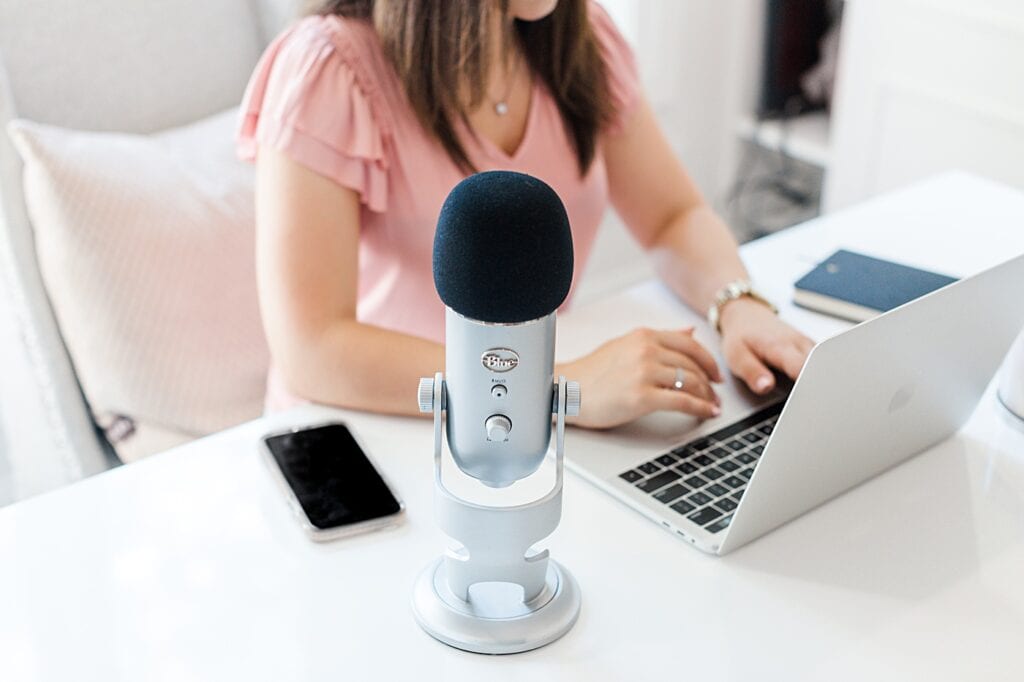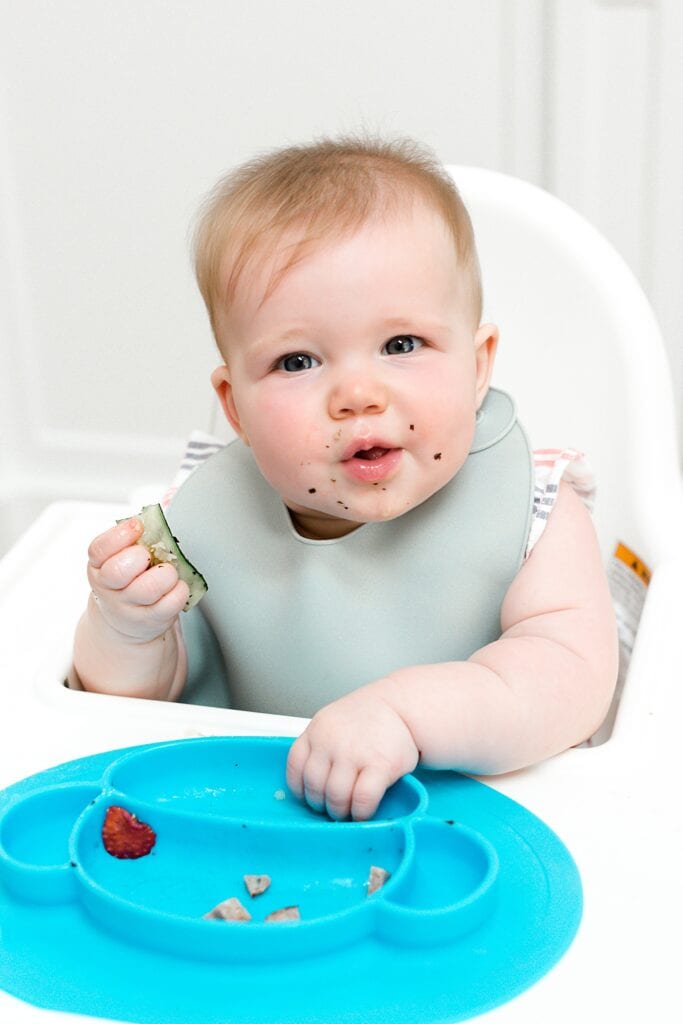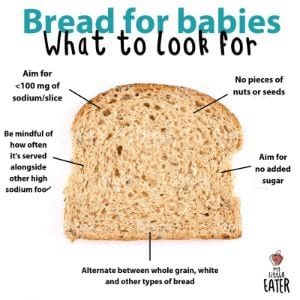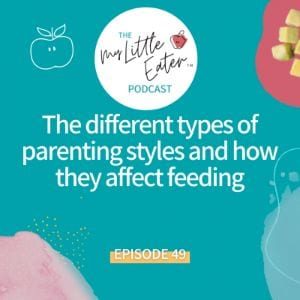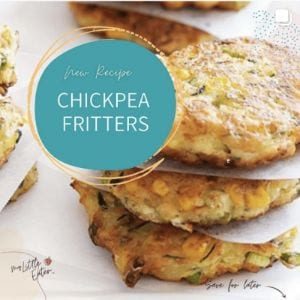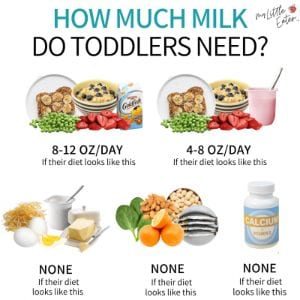Like most new parents, you might be super anxious and scared when your baby starts gagging for the first time. I get it. It can look very scary and be hard to watch before getting some experience and insight on how gagging works!
Questions I get from parents all the time, include:
Is gagging normal for babies?
How do I know if my baby is gagging too much?
How do I progress in textures when my baby gags so much?
How do I help decrease my baby's gagging?
When will my baby’s gag reflex disappear?
You’re not alone, and I’m here to help you get through this stage with your little one and give you the confidence to handle your baby gagging like a pro. Let’s go over everything you need to know!
If you’re feeling stressed or scared about introducing more textured foods and finger foods, register for my FREE workshop – “Baby Led Weaning…but make it purées!You’ll learn all about gradually moving from easier to more advanced textures while overcoming fears about gagging and choking.
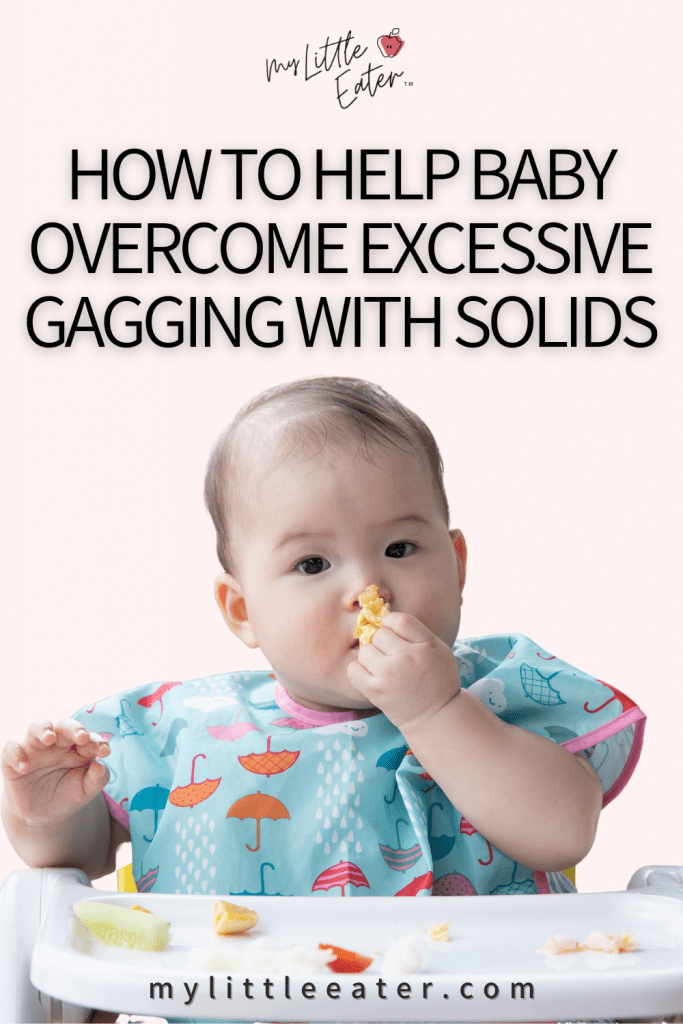
I’ll start by saying that gagging is a very normal and expected part of starting solids. I want to prepare you because you will be seeing a lot of gagging in the initial stages of baby led weaning.
But how can you tell if your baby is gagging excessively and how can you help them overcome it if they are?
Before we tackle all of these topics, let’s first understand gagging and how to not react in these situations (this is super important). We will focus primarily on normal gagging vs excessive gagging in this blog, but to read more about the topic of gagging vs choking, click here.
Is gagging normal?

The gag reflex is a normal, natural and protective reflex to help your baby as they learn how to chew and swallow solid foods, whether it’s purées or finger foods. In essence, it’s the opposite motion of a swallow. When your baby is learning how to eat, the gag reflex is supposed to kick in to help your baby keep food in an area of their mouth that makes it more manageable to chew (or spit out).
I know it can be hard to watch, but it really is okay to see your baby gagging. It doesn’t mean there’s something wrong with your baby, it doesn’t mean they’re struggling and it doesn’t necessarily mean they shouldn’t be having food of that texture. It actually just means their body is doing its job keeping your baby safe as they’re learning how to eat (1).
The hardest part about watching your baby gag, is that you can’t and shouldn’t do anything about it (1). It’s important that you let your baby work through the gag on their own.

Most babies are generally unphased by gagging, and will just keep eating after it passes. If your baby gags and you start to act scared and frantic, they might think they should be frantic too, which can create negative associations with mealtime or specific foods.
We want their natural response reflex (gagging) to do its thing here. Let them stay calm while it happens, and you’ll see they’ll work through the gag and be totally fine.
I totally understand, even after reading this blog, that you may still be TERRIFIED when your baby starts gagging. It can be so scary and stressful to go through this with your little one. If you’re scared, and want a step-by-step approach, sign up for our FREE workshop on how to transition from purées to finger foods (without the fear) here.
How much gagging is normal?

Different babies will gag on different foods (purées or finger foods), at different times, and throughout different points in the starting solids journey. Gagging is considered to be normal and harmless if your baby is able to continue their meal without discomfort, and they go back for more food (if they’re still hungry).
For the most part, babies gag more in the earlier stages of starting solids (between 6-9 months of age). This is because the gag reflex is actually most sensitive during this time.
The gag reflex starts off being easily triggered when food is at the front third of the tongue (2). When something touches this area, or goes slightly past it, they’ll likely start gagging.
This is actually a good thing. It allows baby to practice with food in their mouth and learn to chew, all while being extra protected by their sensitive gag reflex. This also means it will be safer for baby to experience more advanced textures during this time (6 to 9 months) since they have this extra protective mechanism in place.
As you allow your baby to become accustomed to having food of different types in their mouth, the gag reflex will slowly start to move towards the back two-thirds of the tongue (2). This makes sense, as your baby will have had much more practice and not need to be so heavily protected with an extra sensitive gag reflex (1).
Does gagging go away on its own?

No, gagging won’t necessarily go away on its own. Babies who weren’t introduced to textured foods and given ample opportunities to gag in the beginning, between 6 to 9 months of age, will most likely still gag as older babies.
In fact, it may be harder for them because they’re SO used to purées at that point. New textures will be extremely difficult for them to manage.
If you’ve been offering purées for some time and don’t see any gagging, or only notice it on occasion, your baby has mastered the texture of purées. This means they’re ready to move on and explore more advanced textures.
It’s not beneficial to keep offering only purées once baby has mastered this texture. Although it may be easier for them and you during meal times, it doesn’t allow baby to advance their eating skills. Check out my blog on why you need to start your baby on textured finger foods asap here.

Delaying introduction of textured foods in hopes that they won’t gag as much as older babies can actually be worse because it prevents them from getting the practice with these foods early on when their gag reflex is more sensitive (and therefore more protective) (2).
We want to use the time between 6-9 months of age (also known as the critical period) for babies to explore as much food as possible, advance in textures, and build on their oral motor skills (aka the skills required to chew and eat and swallow) (2, 3). Doing that while their gag reflex is nice and sensitive is safer (2, 3).
Check out my blog on why food before one is not just for fun, to learn more about the importance of introducing solids at the right time.
And if you’re feeling stressed or scared about introducing more textured foods and finger foods, register for my free workshop, “Baby Led Weaning…but make it purées! How to move from purées to finger foods – without the fear!” You’ll learn all about gradually moving from easier to more advanced textures while overcoming fears about gagging and choking.
The good news – most babies usually outgrow gagging after a few months of practice with solid foods, finger foods, and a variety of different textures. There is no specific age when your baby’s gag reflex will disappear. In fact, it will never disappear but will become less sensitive overtime.
Every baby is different and it really all depends on the frequency and variety of solid textured foods being offered. Be patient, it will take time and consistency for your little one to master all of these new textures. This is one of the first steps in helping your baby become a happy, healthy little eater long-term!
How do I diminish my baby’s gag reflex?
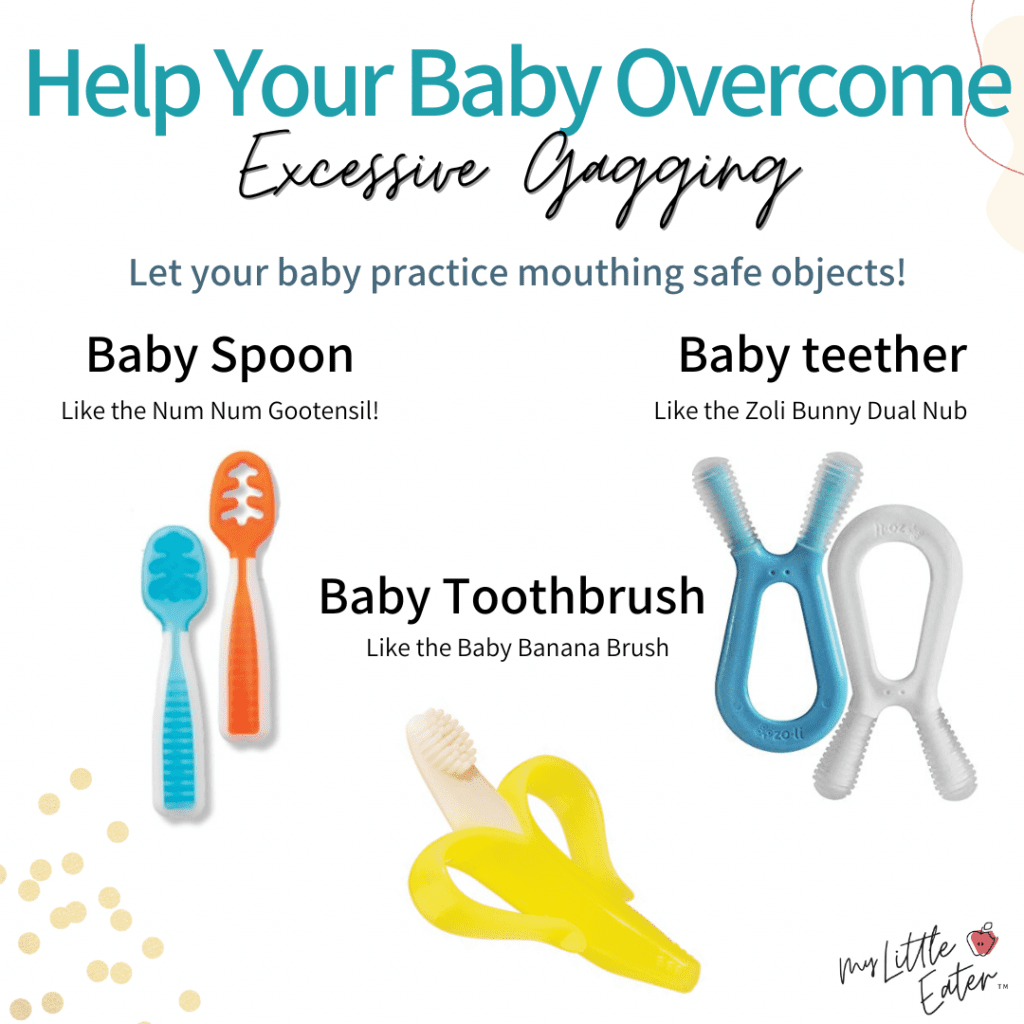
To help your baby overcome their sensitive gag reflex, you can offer long safe objects your baby can mouth until you start to see a decrease in the frequency of gagging, either with objects or during meals!
Long shaped teethers, baby spoons, and baby toothbrushes are perfect! Allowing baby to experience placing these objects far back and in different areas in their mouth helps desensitize that gag reflex and pushes it further back in the mouth.
Children with sensitive gags often do better if they can feed themselves, so allow them to feed themselves for all or part of the meal. During meals, offer baby big pieces of food they can poke around and safely explore the boundaries of their mouth with. These foods should be hard resistive foods with low choking risk, like a chicken drumstick bone, mango pit, or thick watermelon rind for example.

If you’re worried about gagging, and want a step-by-step approach…sign up for our FREE workshop on how to transition from purées to finger foods (without the fear), here.
Is vomiting with gagging normal?
Infrequent vomiting induced by gagging is normal for babies. For some babies, gagging can be a bit more forceful, and as they push to get food to the front of their mouth, they may do it with enough force that they vomit a little.
All babies are different, and some have a more sensitive gag reflex than others. So your baby may never vomit from a gag, or they may do it more often when new foods and textures are being introduced.

To decrease the likelihood of vomiting from a gag, make sure your baby doesn’t have a full belly from a milk feeding when you offer solids. That is because this can make a forceful gag more likely to turn into vomiting, if they haven’t had enough time to digest the milk.
Also, giving your baby lots of practice with long, resistive finger foods or teethers (away from meal time) will help them work towards diminishing that sensitive gag reflex and vomiting with gagging will eventually become less frequent.
Essentially, if your baby is experiencing occasional vomiting with a specific texture, this is ok! Just make sure you keep practicing with that same texture for at least a couple more days, or even a few more weeks, if they need it to help them get accustomed to it before moving on.
When vomiting with gagging may be a concern
There are some red flags to look out for that may indicate something more serious is going on.
Vomiting shouldn’t be so frequent that it happens at most meals, or always with specific textures despite weeks of practice with that texture. Vomiting also shouldn’t cause mealtime to be a traumatic or a negative experience for your baby. If it is something that is causing your baby to be agitated at mealtime, please seek help from a feeding therapist.
Also, know that vomiting shortly after a meal can be a sign of an allergic reaction and/or FPIES.
FPIES is a type of food allergy that can cause repetitive vomiting, diarrhea and dehydration (4). FPIES reactions are triggered by eating a particular food. The most common foods include soy and dairy products, grains (rice, barley, oats), and chicken, turkey and fish (4).
A reaction might not be so obvious, since vomiting may not occur until several hours after the triggering food is eaten. If you do suspect your child has symptoms of FPIES, see an allergist for diagnosis and treatment.
How do I know if my baby is gagging excessively? When do I seek help?

We know that babies gag a lot when they first start solids, but how do you know if your baby is gagging more than normal?
Gagging is not something that should be holding your baby back from eating. If your baby is gagging excessively throughout every meal on one specific texture, you may need to go back to an easier texture and allow them to keep practicing and master that texture before moving on again/seeking help.
Some red flags to watch for include:
- Your baby continuously gagging at most meals even after 2 months of daily practice with a variety of advanced textures and finger foods (of if they’re past 9 months of age).
- Your baby becomes upset after gagging and doesn’t want to continue eating (crying, tantrums, food refusal).
- Your baby continues to vomit with gagging at most meals even with an empty belly.
If you see any of these red flags, seek out help from your doctor and ask for a referral for a feeding evaluation to rule out any medical or sensory issues. This is especially true if your baby is gagging at the sight or touch of food.
However, if your baby is gagging minimally, going back to offering only smooth, puréed foods and hoping that feeding will improve naturally as they get older, doesn’t always work. Most kids with very sensitive gag reflexes need to experience the feeling of texture in their mouth in order to make their gag reflex less sensitive. I have a podcast episode for you about the importance of serving your baby different textures which will explain this further, listen to that episode here.
Bottom line and as our Speech Language Pathologist always says – the only way for a baby to learn how to eat food…is to eat food! We need to give them opportunities to eat food and for gagging to get better. The best way for babies to learn this new skill (yes, eating is a skill!) is to offer them a wide variety of foods with different textures and flavors to give them lots of practice and opportunities to explore.
The more exposure and practice they have with each texture, the more confident they will be with the next, more advanced texture. And before you know it, they’ll be confidently eating all of these new textures like a pro! To help you get there, register for my free workshop “Baby Led Weaning but make it purées – how to move from purées to finger foods without the fear!”.
And if you’re looking for more help for starting solids with your baby, and are ready to feel confident in knowing what to feed your baby and how to do it safely, be sure to check out my Baby Led Feeding online course! I’ll walk you through starting solids with your baby, step-by-step, using whichever method you feel comfortable with to start, and teach you how to gradually progress from there. Don’t spend this important milestone stressed out and worried – actually enjoy meals with your baby instead!
DID YOU FIND THIS HELPFUL? PIN IT TO SAVE FOR LATER!
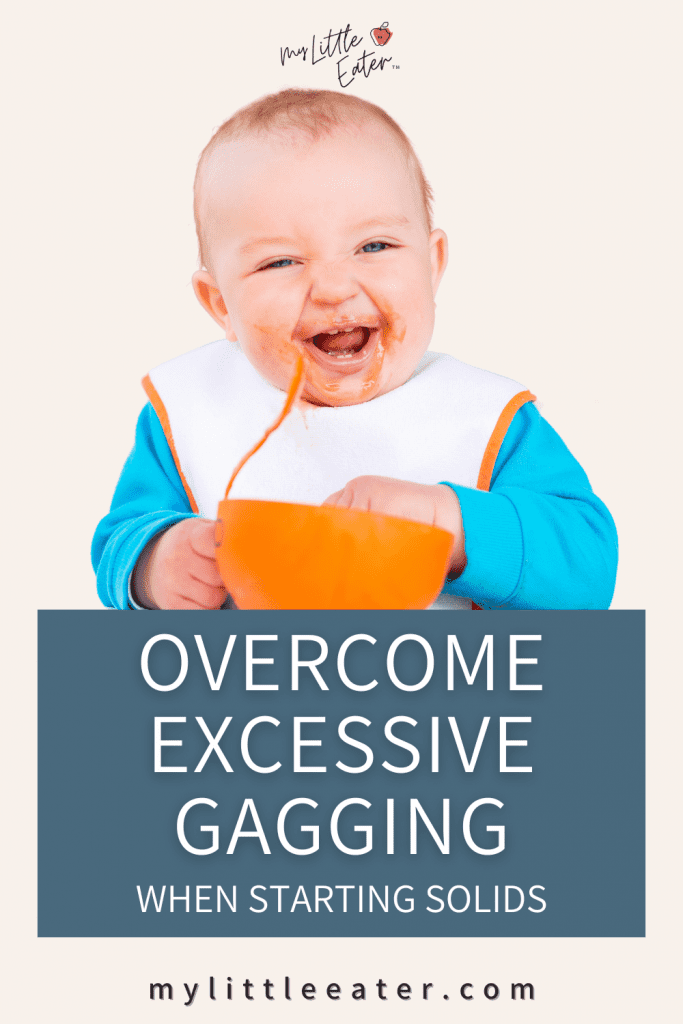
References:
- Rapley, G., & Murkett, T. Baby-Led Weaning, Completely Updated and Expanded Tenth Anniversary Edition: The Essential Guide—How to Introduce Solid Foods and Help Your Baby to Grow Up a Happy and Confident Eater. The Experiment (2019).
- Naylor, A. J., & Marrow, A. L. (2001). Infant Oral Motor Development in Relation to the Duration of Exclusive Breastfeeding. Developmental Readiness of Normal Full Term Infants to Progress from Exclusive Breastfeeding to the Introduction of Complementary Foods, 21–25.
- Coulthard, H., Harris, G., & Emmett, P. Delayed introduction of lumpy foods to children during the complementary feeding period affects child’s food acceptance and feeding at 7 years of age. Maternal & child nutrition, 5(1), 75-85 (2009).
- The American College of Allergy, Asthma, & Immunology. https://acaai.org/allergies/allergic-conditions/food/food-protein-induced-enterocolitis-syndrome-fpies/
